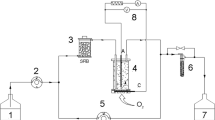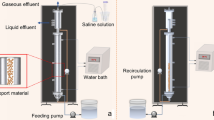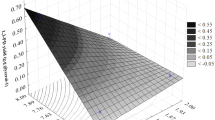Abstract
Among the greatest challenges to the full implementation of biological sulfate reduction are the cost and availability of the electron source. With the development of the biofuel industry, new organic substrates have become available. Therefore, this work sought to compare the performance of a sulfidogenic process utilizing either lactate or glycerol as the substrate for sulfate-reducing bacteria (SRB) growth. Although sulfate reduction is energetically more favorable with lactate, glycerol is a less expensive alternative because excess production is forecasted with the worldwide development of the biodiesel industry. Continuous experiments were performed in a fluidized bed (FB) reactor containing activated carbon as a carrier for a mixed bacterial population composed of sulfate-reducing and fermentative bacteria. During the lactate-fed phases, incomplete oxidation of lactate to acetate by SRB was the dominant metabolic pathway resulting in as much as 90 % sulfate reduction and high acetate concentrations (2.7 g L−1). Conversely, in the glycerol-fed phases, glycerol degradation resulted from syntrophic cooperation between sulfate-reducing and fermentative bacteria that produce butyrate along with acetate (1.0 g L−1) as oxidation products. To our knowledge, this is the first report of butyrate formation during sulfate reduction in a glycerol-fed continuous-flow reactor. Sulfate concentrations were reduced by about 90 % (from 2,000 to 100–300 mg L−1) when glycerol was being fed to the reactor. Since the FB reactor was able to stand a change from lactate to glycerol, this reactor is recommended as the preferred option should glycerol be selected as a cost-effective alternative to lactate for continuous sulfate reduction.





Similar content being viewed by others
References
APHA (2005) Standard Methods for the examination of water and wastewater, 21st edn. APHA, Washington, D.C.
Barbirato F, Himmi EH, Conte T, Bories A (1998) 1,3-Propanediol production by fermentation: an interesting way to valorize glycerin from the ester and ethanol industries. Ind Crops Prod 7:281–289. doi:10.1016/S0926-6690(97)00059-9
Barbosa LP, Bertolino SM, Freitas PC, Oliveira VA, Pina PD, Leão VA, Teixeira MC (2009) Effects of differnt COD/sulfate ratios on the growth of metal tolerant sulfate reducing bacteria (SRB). In: Donati E, Vieira MR, Tavani EL, Giaveno A, Lavalle TL, Chiacchiarini P (eds) IBS 09—International Biohydrometallurgy Symposium. Trans Tech Publications, Bariloche, pp 569–572
Barton LL (1995) Sulfate-reducing bacteria. Biotechonology handbooks, vol 8. Plenum Press, New York
Bertolino SM, Rodrigues ICB, Guerra-Sá R, Aquino SF, Leão VA (2012) Implications of volatile fatty acid profile on the metabolic pathway during continuous sulfate reduction. J Environ Manag 103:15–23. doi:10.1016/j.jenvman.2012.02.022
Biebl H, Spröer C (2002) Taxonomy of the glycerol fermenting clostridia and description of Clostridium diolis sp. nov. Syst Appl Microbiol 25:491–497
Bondioli P, Della Bella L (2005) An alternative spectrophotometric method for the determination of free glycerol in biodiesel. Eur J Lipid Sci Technol 107:153–157. doi:10.1002/ejlt.200401054
Cao J, Zhang G, Mao Z, Fang Z, Yang C (2008) Presipitation of valuble metal from bioleaching solution by biogenic sulfides. Miner Eng 135:40–46
Celis-García LB, Razo-Flores E, Monroy O (2007) Performance of a down-flow fluidized bed reactor under sulfate reduction conditions using volatile fatty acids as electron donors. Biotechnol Bioeng 97:771–779. doi:10.1002/bit.21288
Celis-García L, Villa-Gómez D, Alpuche-Solís A, Ortega-Morales B, Razo-Flores E (2009) Characterization of sulfate-reducing bacteria dominated surface communities during start-up of a down-flow fluidized bed reactor. J Ind Microbiol Biotech 36:111–121. doi:10.1007/s10295-008-0478-7
Dinkel V, Frechen F, Dinkel A, Smirnov Y, Kalyuzhnyi S (2010) Kinetics of anaerobic biodegradation of glycerol by sulfate-reducing bacteria. Appl Biochem Microbiol 46:712–718. doi:10.1134/s0003683810070069
Drożdżyńska A, Leja Katarzyna, Czaczyk K (2011) Biotechnological production of 1,3-propanediol from crude glycerol. J Biotechnol Comput Biol Bionanotechnol 92:92–100
González-Pajuelo M, Andrade JC, Vasconcelos I (2005) Production of 1,3-propanediol by Clostridium butyricum VPI 3266 in continuous cultures with high yield and productivity. J Ind Microbiol Biotechnol 32:391–396. doi:10.1007/s10295-005-0012-0
INAP (2003) Treatment of sulphate in mine effluents. International Network for Acid Prevention, Salt Lake
Kaksonen AH, Franzmann P, Puhakka JA (2003a) Performance and ethanol oxidation kinetics of a sulfate-reducing fluidized-bed reactor treating acidic metal-containing wastewater. Biodegradation 14:207–217. doi:10.1023/a:1024262607099
Kaksonen AH, Riekkola-Vanhanen M, Puhakka JA (2003b) Optimization of metal sulphide precipitation in fluidized-bed treatment of acidic wastewater. Water Res 37:255–266
Kaksonen AH, Plumb JJ, Robertson WJ, Riekkola-Vanhanen M, Franzmann PD, Puhakka JA (2006) The performance, kinetics and microbiology of sulfidogenic fluidized-bed treatment of acidic metal-and sulfate-containing wastewater. Hydrometallurgy 83:204–213
Kolesárová N, Hutňan M, Bodík I, Špalková V (2011) Utilization of biodiesel by-products for biogas production. J Biomed Biotechnol 2011:1–15. doi:10.1155/2011/126798
Leja K, Czaczyk K, Myszka K (2011) Biotechnological synthesis of 1,3-propanediol using Clostridium ssp. Afr J Biotechnol 10:11093–11101
Mizuno O, Li YY, Noike T (1998) The behavior of sulfate-reducing bacteria in acidogenic phase of anaerobic digestion. Water Res 32:1626–1634. doi:10.1016/S0043-1354(97)00372-2
Nagpal S, Chuichulcherm S, Peeva L, Livingston A (2000) Microbial sulfate reduction in a liquid–solid fluidized bed reactor. Biotechnol Bioeng 70:370–380. doi:10.1002/1097-0290(20001120)70:4<370:aid-bit2>3.0.co;2-7
Nevatalo LM, Mäkinen AE, Kaksonen AH, Puhakka JA (2010) Biological hydrogen sulfide production in an ethanol lactate fed fluidized-bed bioreactor. Bioresour Technol 101:276–284
Papanikolaou S, Aggelis G (2003) Modelling aspects of the biotechnological valorization of raw glycerol: production of citric acid by Yarrowia lipolytica and 1,3-propanediol by Clostridium butyricum. J Chem Technol Biotechnol 78:542–547. doi:10.1002/jctb.831
Papanikolaou S, Ruiz-Sanchez P, Pariset B, Blanchard F, Fick M (2000) High production of 1,3-propanediol from industrial glycerol by a newly isolated Clostridium butyricum strain. J Biotechnol 77:191–208. doi:10.1016/S0168-1656(99)00217-5
Postgate JR (1963) Versatile medium for the enumeration of sulfate-reducing bacteria. Appl Microbiol 11:265–267
Qatibi AI (1990) Fermentation du lactate, du glycerol et des diols par les bactéris sulfato-réductrices du genere Desulfovibrio. Université de Provence, Docteur
Qatibi AI, Bennisse R, Jana M, Garcia J-L (1998) Anaerobic degradation of glycerol by Desulfovibrio fructosovorans and D. carbinolicus and evidence for glycerol-dependent utilization of 1,2-propanediol. Curr Microbiol 36:283–290. doi:10.1007/s002849900311
Rampinelli L, Azevedo R, Teixeira M, Guerra-Sá R, Leão V (2008) A sulfate-reducing bacterium with unusual growing capacity in moderately acidic conditions. Biodegradation 19:613–619
Rodrigues ICB (2012) Métodos moleculares aplicados a biotecnologias relacionadas ao ciclo do enxofre. Universidade Federal de Ouro Preto
Sahinkaya E, Özkaya B, Kaksonen AH, Puhakka JA (2007) Sulfidogenic fluidized-bed treatment of metal-containing wastewater at low and high temperatures. Biotechnol Bioeng 96:1064–1072. doi:10.1002/bit.21195
Zellner G, Neudörfer F, Diekmann H (1994) Degradation of lactate by an anaerobic mixed culture in a fluidized-bed reactor. Water Res 28:1337–1340
Zhao Y, Ren N, Wang A (2008) Contributions of fermentative acidogenic bacteria and sulfate-reducing bacteria to lactate degradation and sulfate reduction. Chemosphere 72:233–242. doi:10.1016/j.chemosphere.2008.01.046
Acknowledgments
The financial support from the funding agencies FINEP, FAPEMIG, CNPq and CAPES as well as Vale is gratefully appreciated. The Conselho Nacional de Pesquisas—CNPq scholarships to S. M. Bertolino, L. A. Melgaço, S. F. Aquino and V. A. Leão are especially acknowledged.
Author information
Authors and Affiliations
Corresponding author
Rights and permissions
About this article
Cite this article
Bertolino, S.M., Melgaço, L.A., Sá, R.G. et al. Comparing lactate and glycerol as a single-electron donor for sulfate reduction in fluidized bed reactors. Biodegradation 25, 719–733 (2014). https://doi.org/10.1007/s10532-014-9694-1
Received:
Accepted:
Published:
Issue Date:
DOI: https://doi.org/10.1007/s10532-014-9694-1




